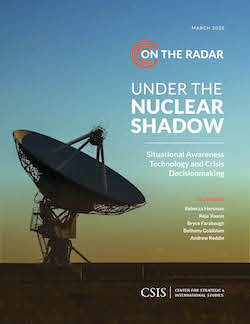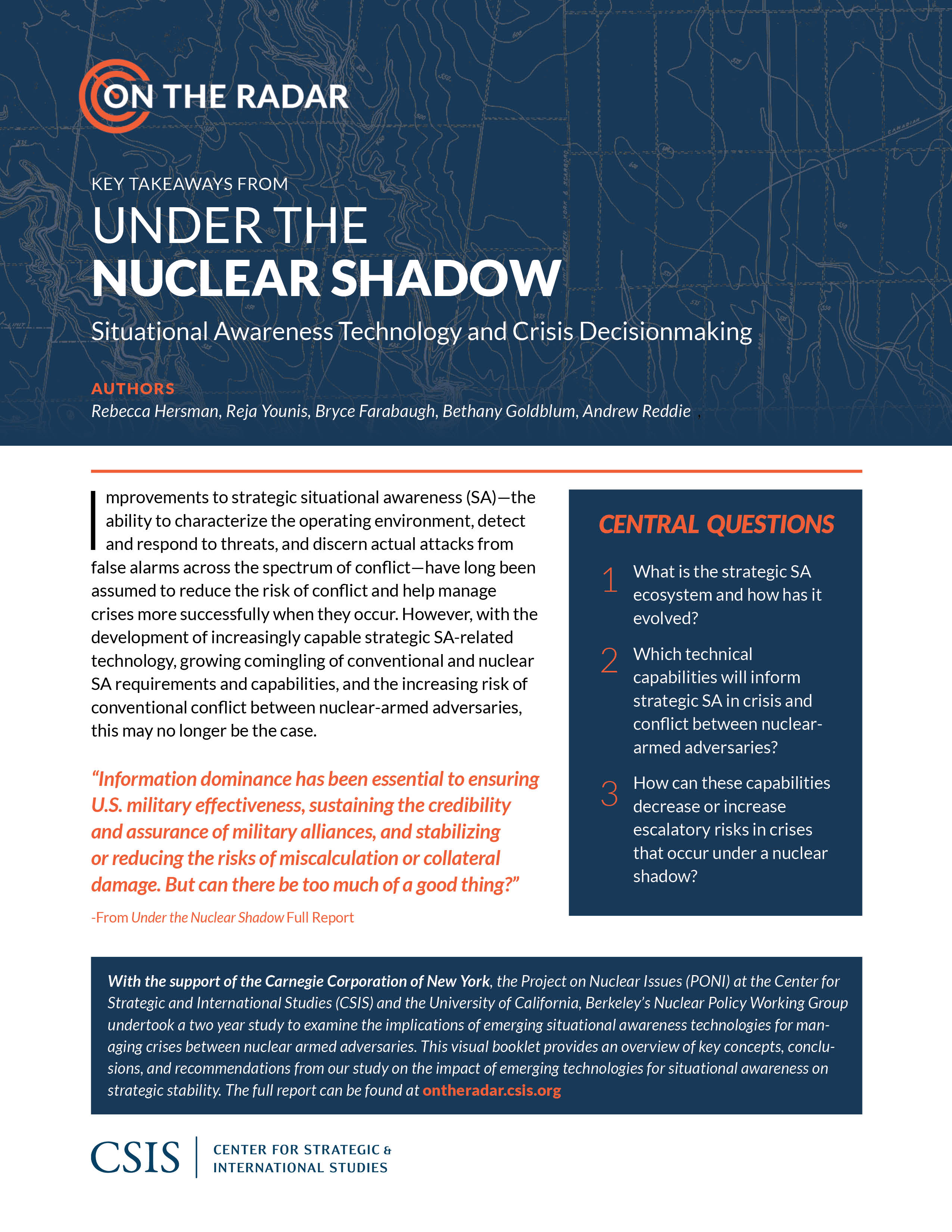Under the Nuclear Shadow Situational Awareness Technology and Crisis Decisionmaking
Download Under the Nuclear Shadow
Information dominance has been essential to ensuring U.S. military effectiveness, sustaining the credibility and assurance of military alliances, and stabilizing or reducing the risks of miscalculation or collateral damage. But can there be too much of a good thing?
B-52H Stratofortress, Sept. 16, 2016.
(U.S. Air Force photo/Airman 1st
Class J.T. Armstrong)
Improvements to strategic situational awareness (SA)—the ability to characterize the operating environment, detect and respond to threats, and discern actual attacks from false alarms across the spectrum of conflict—have long been assumed to reduce the risk of conflict and help manage crises more successfully when they occur.
However, with the development of increasingly capable strategic SA-related technology, growing comingling of conventional and nuclear SA requirements and capabilities, and the increasing risk of conventional conflict between nuclear-armed adversaries, this may no longer be the case.
What is the emerging strategic SA ecosystem?
Capability Classifications
- Conventional
- Capabilities that provide theater and battlefield-level situational awareness, to include related indications, warning or other operational information as well as information on the status, location, and condition of conventional assets and capabilities.
- Nuclear
- Capabilities that provide indications, warning or other operational information on the status, location, or condition of adversary nuclear weapons, delivery or command and control systems.
The emerging SA ecosystem is highly networked, real-time, and dual-use, creating a landscape that is highly capable but also murkier and more complex. The rapid pace of technological advancement, dual-use (conventional and nuclear) applicability of emerging capabilities and blurring of lines between nuclear and conventional command and control are reshaping the emerging landscape. This emerging SA ecosystem can provide vast amounts of information, more quickly and more precisely than ever before, including about new forms of strategic attack that may prove elusive to traditional warning systems.
Why Does this Matter?
- The risk of crisis or conflict between nuclear-armed states—some of which integrate conventional and nuclear forces in their military strategies or employ dual-use (nuclear and conventional) delivery systems—is increasing.
- Nuclear-armed states are increasingly reliant on a single strategic SA-enabled ecosystem for both nuclear and conventional crisis and conflict, raising new escalation challenges and prompting reconsideration of the value and stabilizing nature of information dominance in a crisis.
- New technologies provide more information quicker and with greater precision than ever before, challenging decisionmakers’ ability to effectively manage risk and adjudicate the high stakes involved.
What technologies were explored during On the Radar?
The following table lays out the technologies explored by this project. The table is not exhaustive, but it represents strategic SA capabilities across all domains and is representative of the emerging SA ecosystem.
Sea
Air
Land
Space
Cyber
Defense
- P = Platform
- CE = Critical Enabler
| Strategic SA Capability | Domain & Type | Definition | Example of Strategic SA Application | Demonstrative Technology | Dominant Attributes | Dominant Risk Factors |
|---|---|---|---|---|---|---|
| Autonomous Unmanned Underwater Vehicle (UUV) |
|
Sea-based sensor platform with little to no human input | Employed to track submarine and surface vessels | Large Diameter UUV (LDUUV) | Vantage/ Range, Persistence | Intrusive, Preemptive |
| Unmanned Underwater Vehicle (UUV) Swarms |
|
Groups of UUVs networked together | Swarms to specific submarine or surface vessel target (including ports) | Aquabotix UUV Swarm | Persistence, Resiliency/ Reliability | Intrusive, Action-enabling |
| Unmanned Underwater Vehicle (UUV) Nets |
|
UUVs deployed to passively monitor geographic chokepoints | Static/slow-moving UUVs deployed to littoral waters/geographical chokepoints to track submarine and surface vessel activity | Persistence, Precision | Preemptive, Clandestine | |
| Unmanned Surface Vehicle (USV) |
|
Unmanned surface platform capable of being underway for weeks on end | Used to patrol, track, and deploy a range of smaller USV and UUV systems | U.S. Navy Autonomous Swarmboats; Aquabotix USV Swarm | Vantage/ Range, Precision | Intrusive, Vulnerable |
| High-altitude, Long Endurance (HALE) UAV |
|
Unmanned aerial vehicle with wide range of sensor capabilities | Surveil adversary capabilities at high altitude and maneuverable to lower altitudes | RQ-4, RQ-180 | Vantage/Range, Precision | Intrusive, Vulnerable |
| High-altitude Pseudosatelites |
|
Extremely high-altitude UAVs with lengthened wingspan; able to surveil an area of interest for days to weeks | Provides long-term, persistent coverage of land and surface targets from over 65k feet in altitude | Airbus Zephyr; Boeing PhantomEye | Vantage/ Range, Persistence | Intrusive, Vulnerable |
How Could These Capabilities Contribute to Escalation?
Of particular concern are three potential escalation pathways—provocation, entanglement, and information complexity—that may be triggered or exacerbated with the use of emerging strategic SA-enhancing capabilities. During an actual crisis, multiple pathways may be activated, either simultaneously or sequentially. Examining each of these escalatory pathways individually provides insight into the interplay of strategic SA technologies and stability risks.

Provocation
Decisionmakers’ perception of information collection as either offensive or incentivizing an offensive advantage
Escalation through provocation can occur when parties to a crisis perceive information collection activities as offensive in nature, or believe such actions create an offensive advantage. On this pathway, one or both parties may believe escalatory steps are controllable or unavoidable. This inability to delineate intentions can result in a spiraling sequence of tit-for-tat actions and reactions and a loss of escalatory control. Additionally, the applicability of strategic SA capabilities to inform or enable preventive or pre-emptive action further complicates these offense/defense perceptions and may introduce highly provocative first mover incentives.
Policymakers were highly attuned to the escalatory risk associated with intrusive technologies, often weighing their concerns about the potential provocational risks to be more important than the situational awareness benefit that capabilities may provide.


Entanglement
Decisionmakers’ inability to delineate between nuclear and conventional risks

Escalation through strategic SA entanglement happens when parties to a crisis or conflict are unable to delineate between nuclear and conventional risks, thereby increasing the risk of miscalculation and unintended escalation. These risks can lead decision-makers to believe either their own nuclear forces are vulnerable to a disarming strike or there is an opportunity to disarm an adversary. More specifically, entanglement in the strategic SA space occurs when conventional SA systems intentionally or unintentionally collect information on nuclear assets, or when dual-use SA systems become military targets during a conventional conflict.
The capabilities designed to provide situational awareness and support senior decisionmaking in crisis and conflict are increasingly comingled into a single conventional/nuclear ecosystem.

Information Complexity
Decisionmakers’ inability to seek, manage, and interpret information effectively

Escalation through information complexity results from decisionmakers’ inability to seek, manage, and interpret information effectively. This can result in decisional paralysis or biased decision-making that impairs effective crisis management. In a complex information environment, where data may be neither easily understood nor highly trusted and relies on unfamiliar technologies, cognitive processes could increase both the risks and the stakes in crisis decision-making.
Psychology, particularly in the form of pre-existing beliefs and cognitive biases, is underappreciated when examining the relationship between crisis decisionmaking and emerging technology.
Tabletop Exercises
The project ran a series of tabletop exercises to better understand how policymakers evaluate risks associated with employing emerging technologies to enhance situational awareness during crises between nuclear-armed adversaries.
- 5 locations
- 4 different states
- 40+ hours of discussion
- 150 (approx) participants, including next-generation scholars, mid-career professionals, and senior experts
Policymakers were highly attuned to the escalatory risk associated with intrusive technologies, often weighing their concerns about the potential provocational risks to be more important than the situational awareness benefit that capabilities may provide.
Blind Spot
China exercise
In the year 2024, tensions run high as a close-approach incident between the Chinese and Taiwanese navies in the Taiwan Strait sets off a crisis. The United States reaffirms its commitment to defending Taiwan against Chinese aggression as concerns rise over a flash invasion. Complicated by the introduction of grey-zone tactics like satellite “dazzling” and GPS spoofing that significantly limit American visibility in the region, the situation threatens to escalate a regional crisis into a full-blown conflict between near-peer adversaries.
Risky Business
North Korea exercise
In the year 2025, a crisis unfolds as North Korea takes provocative actions against South Korea, including seizing an island, taking South Korean soldiers hostage, and ultimately establishing a forward position 20 KM south of the Demilitarized Zone. United States forces on the peninsula are on high-alert as North Korean intentions are unclear and intelligence indicates growing North Korean confidence in their nuclear deterrent. With American troop reinforcements 30 days away, the situation threatens to escalate an inter-Korean dispute into a conflict between two asymmetric nuclear powers.
The Way Ahead
In any crisis between nuclear powers, the nuclear shadow will loom large. This environment will require new perspectives on the value and risks associated with information dominance and its impact on nuclear crises. To effectively manage crisis escalation, decisionmakers must understand how the strategic SA ecosystem has evolved, appreciate the dynamic relationship between improved strategic SA and crisis stability, and recognize the complex interplay between technology, escalation, and decisionmaking.
An unmanned underwater vehicle, May. 14, 2013. (U.S. Navy photo by Mass Communication Specialist 1st Class Daniel Gay/Released)
Key Conclusions
- The growing nuclear shadow requires new perspectives on the value and achievability of information dominance.
- The combined conventional/nuclear strategic SA ecosystem is here to stay.
- The combined conventional/nuclear strategic SA ecosystem will shape, not just inform, crises with nuclear-armed states.
- High stakes and unfamiliar technologies may increase the risk of biased decisionmaking.
Recommendations
- Close the divide between technology and policy regarding the benefits, risks, and requirements for strategic SA capabilities.
- Integrate strategy, planning, and operations between the conventional and nuclear communities to better prepare for conventional crises under a nuclear shadow.
- Engage with allies and potential adversaries on issues of technology, information, and warning to better understand thresholds, risks, and perceptions in early crisis.
- Seek ways to make strategic SA capabilities and the information they provide more adaptable and flexible to potential requirements for enhanced transparency, signaling, self-attribution, information sharing, and public disclosures.





